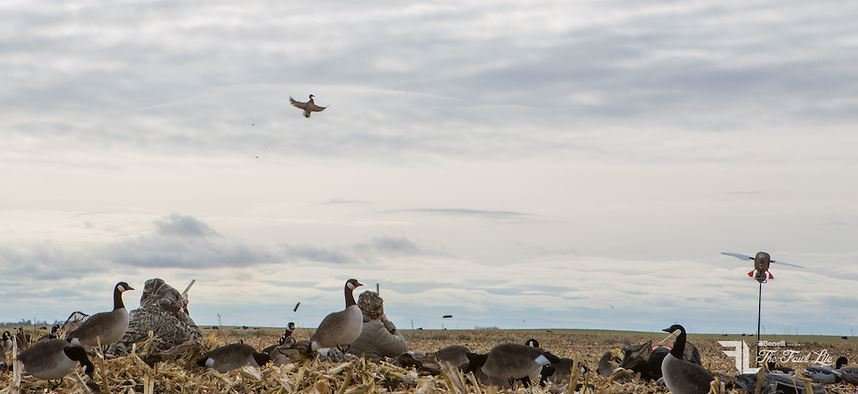Forecasted cold front could move some birds soon . . .
October 23, 2015
Location: Northern portion of the Central Flyway
Major Weather Trends: After solid duck openers throughout the northern portion of the flyway, unseasonably warm weather has slowed the action. Mid-October temperatures routinely hit the 60s or even 70s in the Dakotas, minimizing duck and goose activity and leaving hunters wishing for hard frosts and northerly winds.
Our weather has been rather benign in terms of the migration — warm and dry, just like North Dakota, said John Pollmann, an avid waterfowl hunter from South Dakota. The weather conditions have allowed farmers to ramp up harvesting efforts.
Mark Vrtiska, waterfowl specialist/program manager for the Nebraska Game and Parks Commission, told a similar tale.
Opening weekend and the second weekend were pretty decent for hunting, he said. Since then, it's been quite warm, even getting into the 90s one or two days. I don't believe we've seen much move in in terms of ducks or geese.
Water Conditions: The northern portion of the flyway hasn't seen much rain lately, which isn't welcome news.
The warm conditions also have been followed by a lack of precipitation, so we're losing a bit of water, which is not good, Vrtiska said.
Pollmann concurred.
Our wetland conditions continue to deteriorate with the lack of moisture, he said. I hunted west of Watertown last weekend and saw large, semi-permanent wetland basins completely dry. I know there are places still holding good water, but overall, the state is in need of some moisture.
My recent observations in central North Dakota were similar. Dry weather had water levels receding, but mud flats along slough edges were still manageable. Some seasonal wetlands had dried up.

Habitat Conditions: As Pollmann mentioned, ideal conditions have farmers busy. Most soybeans in the Dakotas have been cut, and folks were starting to take corn and sunflower fields.
Species and Numbers: Vrtiska said Nebraska was holding mostly dabbling ducks but few mallards. Pollmann said there had been some movement of calendar ducks into South Dakota but no major influx of northern birds.
The area I hunted last weekend was holding a surprising number of pintails, and given how production for those birds was down in South Dakota this year, I think their presence confirmed my thought that calendar ducks are on the move, he said. Strong numbers of green-winged teal (boreal forest-nesting ducks) also confirms that we've gotten a small push of birds. We typically see another calendar push October 25 through 28, and with next week's forecasted cold front, I suspect that we'll see that push and maybe a few more.
Personal Hunting Report: My North Dakota trip featured challenging conditions but good local bird numbers. Primary species in the bag included gadwall, mallard, wigeon, green-winged teal and blue-winged teal. Pintail, shoveler and Canada goose numbers also appeared strong. Migration activity was slow, as we saw few fresh puddle-duck flights and fewer divers. Tundra swan numbers built slowly during our stay, and we observed several large flocks of sandhill cranes
Most days featured cool mornings but warm afternoons. That wasn't a problem if the wind blew, but several days of light winds made hunting more difficult. Scouting was critical, as ducks seemed to move from spot to spot. If they encountered pressure, they'd often relocate to a nearby slough and stay there. By locating birds during evenings and setting up well before shooting light, you could make the most of the first two hours. Having a back-up spot also came in handy. Some mallards were hitting winter wheat fields during evenings, but with little corn cut, field-hunting was just getting started.
Boat Ramp Chatter: Most folks agreed that action was a bit stale and a shot of cold weather would likely bring fresh birds to the area. Devil's Lake-area waterfowlers were experiencing some good diver action, primarily on bluebills, redheads and canvasbacks. Many observers said the snow goose migration was just starting.
Upcoming Patterns/Hotspots: As the corn harvest continues and cooler weather arrives, field-hunting in the Dakotas will only get better. Also, expect more calendar migrants (gadwall, wigeon, pintails, teal and some diving ducks) to filter down as October ticks away. A good shot of rain might refresh some sloughs, but not to the point that water levels would cover up mud flats.
Overall, we need some weather up north before we're going to see things really pick up in South Dakota, Pollmann said. A buddy who guides in the Peace River area of northern Alberta is still smacking greenheads. Until he freezes out and the southern portions of the prairie provinces lock up and get some snow, we're going to be hunting many of the same birds that are here already. I'm hoping next week's cold snap helps improve our hunting, though.
Avid waterfowler Brian Lovett will report on the Central Flyway all season long.






